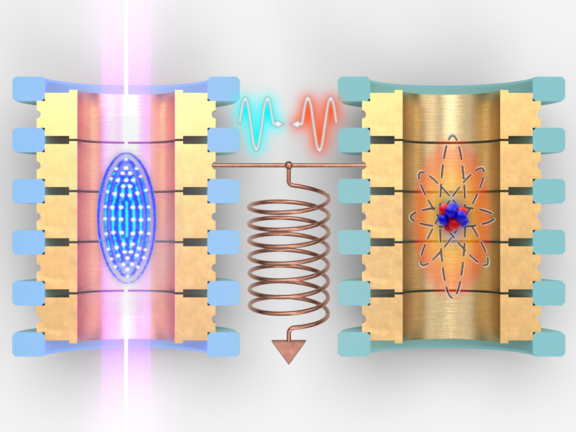Inside Penning traps, ions can be stored by means of magnetic and electric fields in free space for basically infinite time. This provides an ideal environment for precision measurements of fundamental properties like the masses of protons and electrons or their magnetic moments. Even a single trapped ion can be either “seen” via interaction with a laser beam or “heard” by recording the tiny currents induced in the trap electrodes by its motion, similar to a microphone.
Though the ion inside a trap is well isolated from external perturbations, the precision of the measurements is limited by the thermal motion of the ion. Thus, it is essential for further progress in precision to cool down the ion as much as possible. One powerful tool is laser cooling but this is limited only to a few ion species providing appropriate electronic transitions which can be addressed by the laser light. One method to circumvent this problem is to cool an arbitrary ion sympathetically via interaction with another ion that is suitable for laser cooling. The interaction for sympathetic cooling is the natural Coulomb force. Unfortunately, this impedes precision because the strong electrostatic repulsion between the ions alters their motion.
Decades ago, scientists Heinzen and Wineland proposed coupling ions alternatively through the tiny currents they induce into the trap’s electrodes. Group leader Sven Sturm gives the following vivid example: “It’s just as when two children’s swings are loosely coupled by a spring, energy slowly oscillates between the ions in this set-up. If one swing is slowed, after some time the other one will also slow and eventually come to rest”. While cooling one ion will also reduce the temperature of its partner, the precision-limiting side effects of a strong repulsion can be avoided. However, the tiny voltages induced by the ions provide very weak coupling and, thus, very slow sympathetic cooling.
Swings coupled by oscillating weight
The new method proposed by the MPIK scientists is based on the idea to resonantly enhance the coupling strength via an auxiliary resonator circuit. Using the picture given above, Sven Sturm explains the effect: “It’s like adding an oscillating weight in the middle of the spring linking the two children’s swings. When the oscillation frequencies of the ions (kids) are similar to the resonator’s, the resonator (the oscillating weight) starts to oscillate as well and thus enhances the coupling drastically. However, as the ions get colder than the resonator, it starts heating the ions and limits the achievable temperature.”
The physicists choose an optimized detuning of the ions’ frequency from the resonator in order to control the heating rate while maintaining strong coupling: Two highly charged ions were coupled via a common resonator and their coupling strength was measured. Compared to a common Penning trap, by using the linked auxiliary resonator they gained a factor of 760 in coupling strength. “Just as one cannot slow one of the coupled swings by suddenly stopping the other one with a firm grip but rather by continuously slowing it, the strong cooling laser should be switched on only for short periods every few milliseconds” concludes first author Bingsheng Tu, “This way efficient sympathetic cooling can be achieved for almost any arbitrary ion.”
In the future, this new technique could pave the way to new and intriguing measurements that will allow scientists to sharpen the picture of new phenomena in physics.
Original publication:
Tank-Circuit Assisted Coupling Method for Sympathetic Laser Cooling
Bingsheng Tu, Felix Hahne, Ioanna Arapoglou, Alexander Egl, Fabian Heiße, Martin Höcker, Charlotte König, Jonathan Morgner, Tim Sailer, Andreas Weigel, Robert Wolf, and Sven Sturm
Adv. Quantum Technol. 2021, 2100029, DOI: 10.1002/qute.202100029
